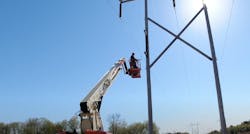Sensors Predict Weather Patterns Affecting Power Transmission Lines
The New York Power Authority announced the installation of new weather sensors on a series of Northern New York transmission lines to generate more reliable weather data. The $1 million Forecast Dynamic Line Rating R&D project, jointly funded by NYPA and the New York State Energy Research and Development Authority (NYSERDA), monitors actual weather conditions at individual transmission towers rather than relying on national forecast data taken miles away. Being able to receive regular updates on real-time conditions including air temperature, wind conditions and solar intensity, will help system operators know more accurately how much power can be delivered through the lines. The demonstration project is the first in the nation to validate the ability to monitor and forecast transmission line capacity all along the transmission lines, including structure to structure spans, instead of using single weather monitor location measurements.
“New York weather is unpredictable and changes by the minute. A real-time technology that provides accurate, detailed forecasting data will help NYPA determine how to safely and reliably move more electricity through existing transmission lines,” said Alan Ettlinger, senior director of Research, Technology Development and Innovation. “This solution can be easily implemented by other utility companies and help transmission line operators enhance the current-carrying capability of New York State’s electric power system and better address congestion issues.”
Sensors have been installed on the Moses-Willis-Plattsburgh transmission lines in ten locations throughout St. Lawrence, Franklin and Clinton counties in New York’s North Country.
Large and well-planned expansion of the state transmission grid and enhanced grid capability is critically needed in New York State to relieve transmission congestion and to integrate renewables into the grid. One of NYPA’s priorities under its VISION2030 strategic vision calls for becoming the state’s leading transmission developer, owner and operator through significant investments in support of the nation-leading Climate Leadership and Community Protection Act (Climate Act), which challenges for New York State to reach a carbon-free electricity system by 2040.
NYSERDA Innovation Operations Manager Richard Bourgeois said: “We’re proud to support technology advances that give utilities the information they need to maximize the capabilities of their equipment. Knowing weather data in real time at specific locations in the transmission system will allow more renewable power to reach more New York homes and businesses.”
NYPA has 1,400 miles of transmission lines that carry power from generation sources to distribution centers and eventually feed both residential and commercial customers. However, many of the lines were built in the ‘60s and ‘70s, and with growing electricity demand, there are often bottlenecks in the transmission system.
The rating of lines by the New York Independent Systems Operator and utilities for how much power a line can transmit is impacted by the weather and like most utilities, NYPA now uses static line ratings based on conservative assumptions about weather conditions to determine how much electricity can safely be pushed through a transmission line. However, transmission lines take circuitous routes through remote areas, through valleys and mountains, and weather, especially in the mountainous regions of New York State, changes dramatically based on wind and light conditions.
“Utilities are being encouraged to use dynamic and smart ratings to deliver more power with existing lines,” said Chunchuan (Charlie) Xu, a senior engineer at NYPA and point on the project. “We will monitor real time conditions, refine our forecasting and share our results so other New York State utilities also can benefit from energy savings and improved transmission performance.”
The project will demonstrate the WindSim Power Line forecast/real-time transmission line rating system that can help enhance the capacity of existing transmission infrastructure and relieve congestion, enabling more efficient utilization of the electric transmission and distribution grid. The technology could enhance the transmission capability up to 60 percent for selected transmission lines, Ettlinger said.
Learn more about the weatherization project and watch a weather sensor installation in NYPA’s video.
